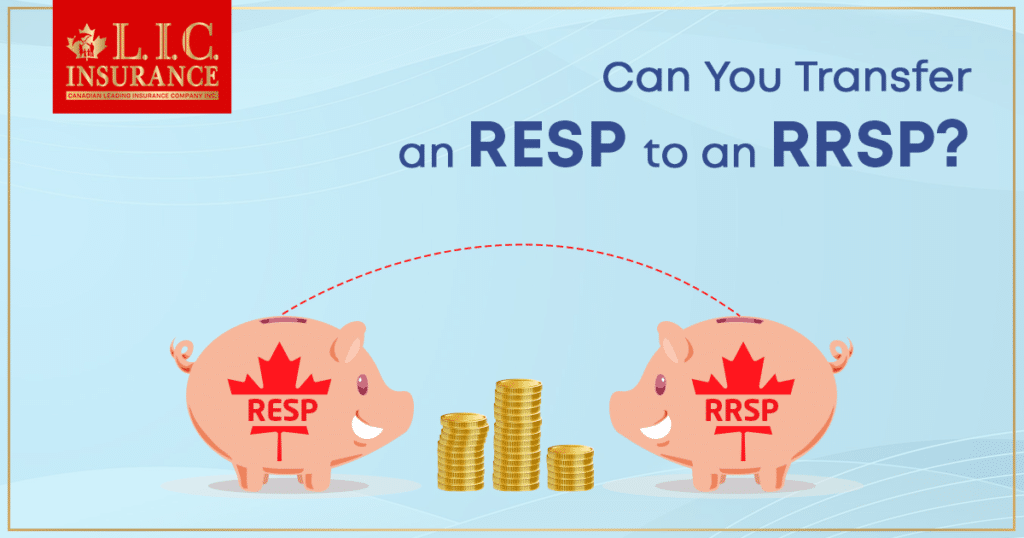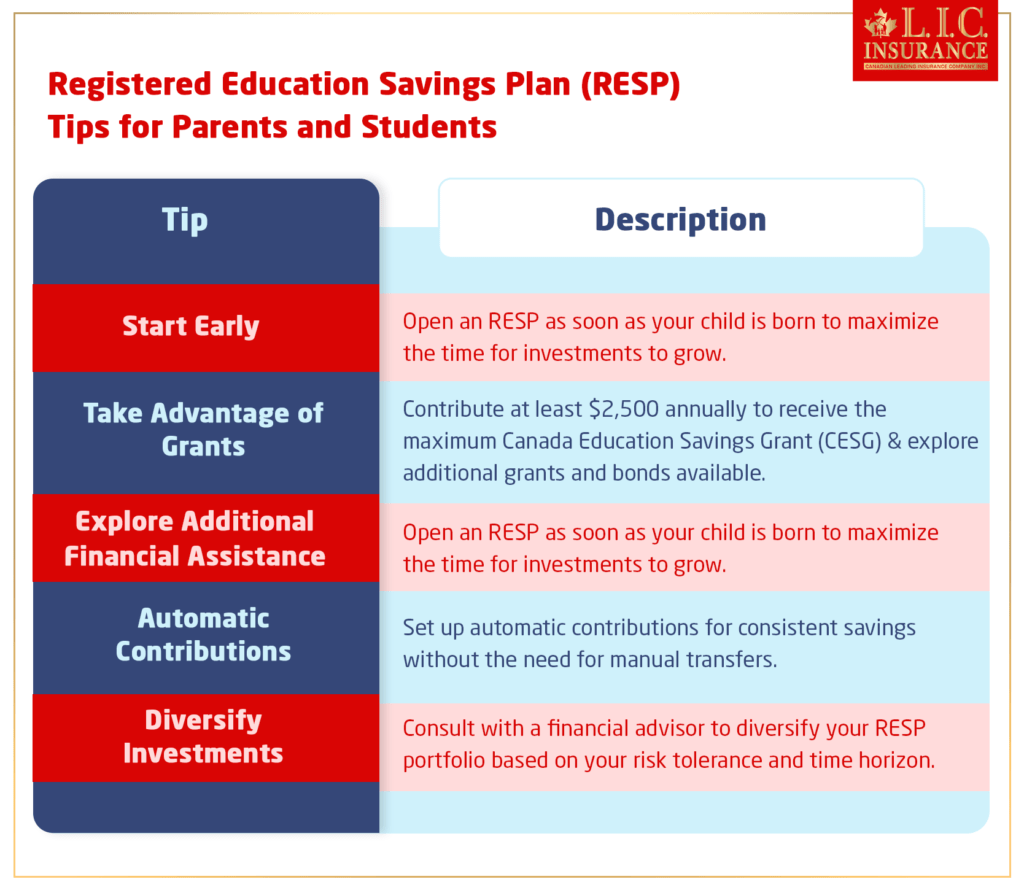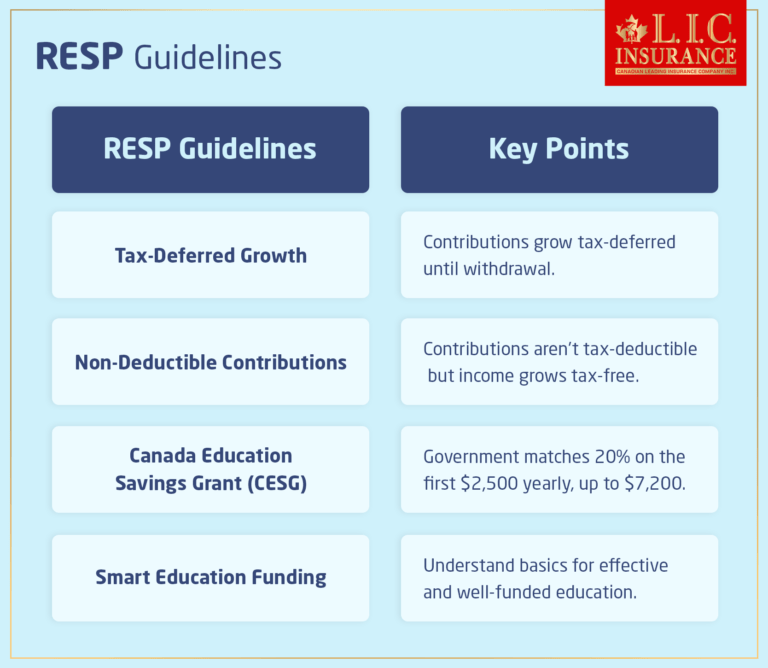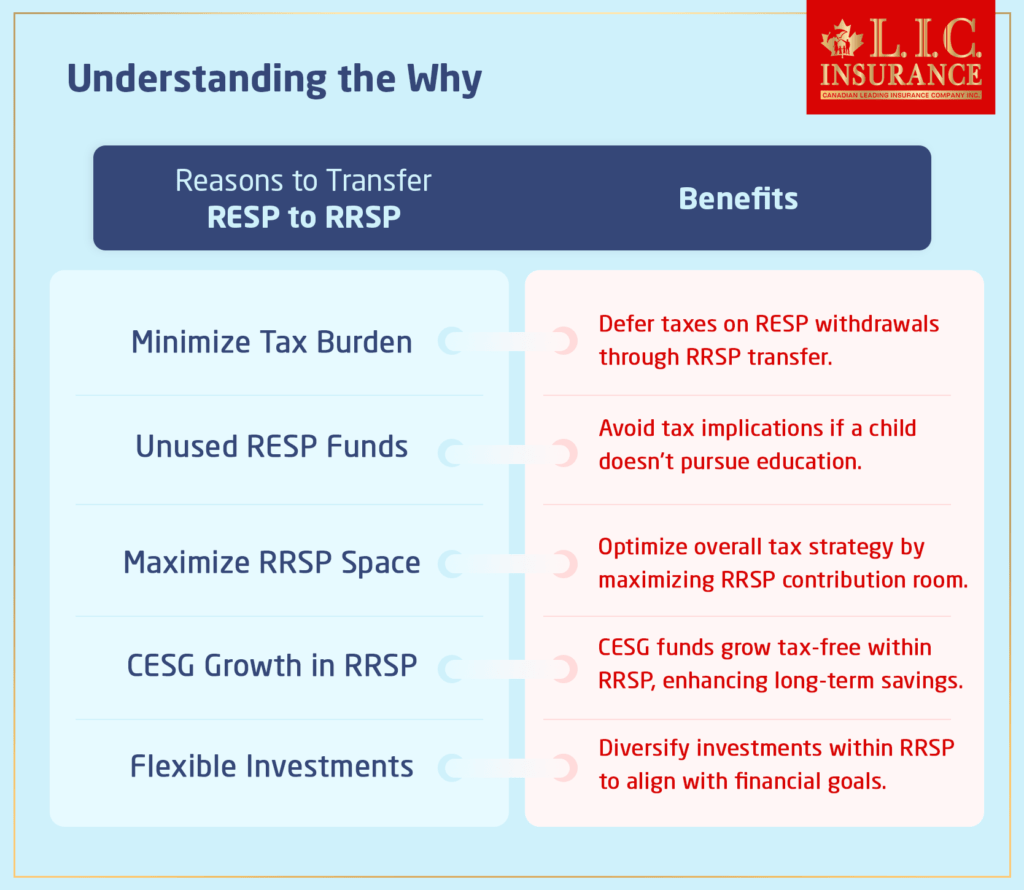- Can You Transfer An RESP To An RRSP?
- Let’s Understand Registered Education Savings Plan
- RESP Guidelines
- Understanding The Why
- Rules For RESP To RRSP Transfers
- Rules For RESP Withdrawals
- Dealing With Limited RRSP Contribution Room
- Step-By-Step Guide For Transferring RESP Funds To An RRSP
- Wrapping It Up

A Registered Education Savings Plan (RESP) is an intelligent way to make sure your kids have the money they need for higher education after high school. However, what many might not know is that there are ways to transfer funds from an RESP to a RRSP. So here we will go into the details of whether you can transfer an RESP to an RRSP and the essential rules and considerations involved. But before we discuss that, let’s first understand what RESP is and what is its importance.
Let’s Understand Registered Education Savings Plan

An RESP is a government-approved savings plan designed to help families save up for their kids’ post-secondary education. After you open an RESP, parents, grandparents, or the remaining family members can contribute money to an account that can be used for tuition, books, and additional education-related expenses at a college, university, or trade school.
RESP Guidelines

If you’re just starting to put money into your child’s Registered Education Savings Plan, here’s what you need to know:
- The money grows tax-deferred until it’s taken out.
- RESP contributions are not tax-deductible, but any investment income within the plan grows tax-free until it’s used for education.
- The Canadian government throws in a little extra with the Canada Education Savings Grant (CESG). It’s a 20% match on the first $2,500 of yearly contributions, up to a lifetime maximum of $7,200 per child.
Understanding these basics will help you make the most of your RESP and ensure your child’s education is well-funded for the future.
Go here to get more clarity on – Why to choose an RESP?
Understanding the Why

So now that we have a basic idea about RESPs, it’s time to discuss the ways to transfer funds from an RESP to a Registered Retirement Savings Plan (RRSP). So why would someone move money that was supposed to go to their child’s education into their own retirement plan? The simple truth is that only some children choose to pursue higher education. In some cases, when your child’s post-secondary education has also been completed some funds are left in their Registered Education Savings Plans even after completing their studies. Transferring these funds to your RRSP can be a profitable move, helping you defer the taxes on the withdrawn amount and making it one of the most beneficial RESP withdrawals for non-educational purposes.
Rules for RESP to RRSP Transfers
Before moving money from your Registered Education Savings Plan (RESP) to your Registered Retirement Savings Plan (RRSP), you should make sure you know the exact rules and conditions that apply to this financial move. For ease of understanding, consider the following points:
Age and Education Status:
Each child beneficiary must be at least 21 years old.
They should not be currently enrolled in post-secondary education.
Tip for Parents: Plan ahead and consider your child’s education for the future when thinking about the RESP to RRSP transfer. Ensure they’ve reached the specified age and are not actively pursuing higher education.
RESP Duration:
The RESP account must have been open for a minimum of 10 years.
Tip for Parents: Start your child’s RESP early to meet the 10-year requirement. The longer the account is open, the more options and flexibility you have for managing the funds.
RRSP Contribution Space:
You need to have enough RRSP contribution space available.
Tip for Parents: Keep track of your RRSP contribution room. Ensure it aligns with the amount you intend to transfer from the RESP. Consult with insurance experts if needed to optimize your contribution space.
Timing and Exceptions:
The transfer is also possible in the 35th year after entering the RESP plan.
Alternatively, it’s allowed if all beneficiaries under the plan have passed away.
Tip for Parents: Be aware of these time-sensitive conditions. If the RESP has been diligently maintained, it can serve as a valuable financial resource well into the future.
Timing and Exceptions:
An RESP can remain open for 35 years, providing flexibility even if your child is not actively pursuing education.
Tip for Parents: Understand the extended lifespan of the RESP. This flexibility makes it possible for you to adapt to changing circumstances and logically decide when and how to utilize the funds.
Hence, understanding these rules and registered education savings plan tips for parents and students is extremely vital before initiating an RESP to RRSP transfer. By having all the required knowledge and planning strategically, you can confidently deal with this financial process, ensuring optimal benefits possible for both you and your child’s future.
Rules for RESP Withdrawals
Knowing the rules for withdrawals when handling your Registered Education Savings Plan (RESP) is very important. These rules should act as a compass to help you manage the financial landscape, whether you’re thinking about withdrawing money for non-educational purposes or thinking about transferring money from an RESP to an RRSP. These simple points will make things clear for parents and students:
Tax-Free Withdrawals on Contributions:
You are super lucky when it comes to your contributions to your RESP; withdrawing them is a breeze and, better yet, tax-free. This means the money you put in is yours to take out without any tax implications. This information is a sigh of relief for parents looking to access the funds they have actively contributed.
Returning CESG or CLB Funds:
A critical point to note is that any grants, such as the Canada Education Savings Grant (CESG) or Canada Learning Bond (CLB), must be handled with care. If these funds are not withdrawn as an Education Assistance Payment (EAP), then in that case these educational assistance payments need to be returned to the government. It’s like a refund policy but with a bit more paperwork. Ensuring compliance with this rule keeps everything running smoothly.
Taxable Income for Non-Educational Withdrawals:
Now, prepare yourself for the tax discussion. There are certain drawbacks to withdrawing income for non-educational purposes. This income is taxable, subject to your regular tax rate plus an extra 20%. While students usually enjoy a low tax bracket during their educational journey, the picture changes when the funds are used for other reasons.
Minimizing Tax Burden with RESP to RRSP Transfer:
Here’s where strategic planning can make a significant difference. To minimize the tax burden associated with income withdrawal, consider transferring funds to your Registered Retirement Savings Plan (RRSP). The beauty lies in the fact that income growth from the RESP, once transferred, remains untaxed within the tax-deferred confines of the RRSP.
Get The Best Insurance Quote From Canadian L.I.C
Call 1 844-542-4678 to speak to our advisors.

Dealing with Limited RRSP Contribution Room
While the maximum transfer amount from RESP to RRSP is $50,000, ensuring you have enough RRSP contribution space is very important. Options for those with limited space include:
- Adding a spouse to the RESP.
- Waiting to build an additional room.
- Adjusting their salary for small business owners to create more contribution space.
Step-by-Step Guide for Transferring RESP Funds to an RRSP
Suppose you find yourself in a situation where you are certain that your child won’t be pursuing further education, and you are considering the strategic move of transferring RESP savings to your RRSP. In that case, following a systematic approach is essential to ensure a smooth process. Here are the steps that are needed to make this move.
Confirm that you meet the transfer conditions:
Before initiating the transfer, confirming that you meet the specific conditions outlined for an RESP to RRSP transfer is crucial. Ensure that each child RESP beneficiary is at least 21 years old and is not currently enrolled in post-secondary education. Additionally, verify that your RESP has been open for a minimum of 10 years and that you have sufficient RRSP contribution space available.
This step is very essential as it sets the foundation for a successful transfer. If you meet these conditions, you are well on your way to taking advantage of the tax-deferred benefits that come with transferring RESP funds to your RRSP.
Check your RRSP contribution room:
Next, assess your RRSP contribution room to ensure you have adequate space for the transfer. Your RRSP contribution room is the maximum amount you can contribute to your RRSP without any penalties. The Canada Revenue Agency (CRA) will give you this information on your most recent notice of assessment.
If you find that your contribution room is limited, consider options such as adding a spouse to the RESP or waiting to build an additional room. Understanding your contribution room is crucial for a seamless and efficient transfer process.
Gather the necessary documents, including your account number:
To initiate the transfer, you’ll need to gather essential documents. These may include your RESP account statements, identification documents, and your RRSP account number. You can speed up the process when you contact your RESP promoter if you have these papers ready in advance.
Your account number, in particular, is essential for a precise and accurate transfer. Double-check the accuracy of this information to eliminate the occurrence of any delays or complications in the transfer process.
Contact your RESP promoter for the required forms and facilitate the transfer:
With your documentation in hand, reach out to your RESP promoter to request the necessary forms for the transfer. Most financial institutions have dedicated customer service teams that can guide you through the process and provide the required paperwork promptly.
Fill out the forms diligently, ensuring all details are accurate and complete. Submit the forms to your RESP promoter, who will then facilitate the transfer of income and coordinate the return of any federal and provincial grants to the government.
Considerations and Potential Fees:
It’s important to be aware that some fees may be associated with this transfer. Your RESP promoter might charge a transfer fee, and there could be an additional fee for closing the account. Depending on your financial institution, you may also encounter a requirement to sell your investments for a cash transfer.
Additionally, keep in mind that the duration of the transfer process can vary. While some transfers may be completed within a couple of weeks, others might take longer. Patience and clear communication with your RESP promoter is key during this phase.
Wrapping It Up
In conclusion, transferring unused RESP funds to your RRSP can be a very clever financial move, reducing your overall tax burden. While the process involves some administrative steps and potential fees, the benefits far outweigh the challenges. Taking the time to understand and execute the transfer properly in case your child doesn’t go to pursue post-secondary education ensures you make the most of your savings. If you’re considering such a transfer, don’t hesitate to consult with your RESP provider for personalized guidance as per your specific situation.
Get The Best Insurance Quote From Canadian L.I.C
Call 1 844-542-4678 to speak to our advisors.
Faq's
RESP stands for Registered Education Savings Plan. It’s a Canadian government-approved savings plan that helps families save for their children’s post-secondary education. Contributions grow tax-deferred until withdrawal.
RESP operates by providing a tax-advantaged way to save for education. Family members contribute, the government offers grants (CESG), and the money grows tax-free. Withdrawals fund qualified educational expenses.
RESP withdrawals are taxable. Contributions are not taxed, but income and government grants are taxed at the beneficiary’s regular rate plus an extra 20%. Transferring to an RRSP can minimize the tax burden.
If your child decides not to pursue higher education or there are remaining funds in their RESP after studies, transferring to your RRSP can defer taxes on the withdrawn amount, offering a strategic move for non-educational purposes.
In order to complete the transfer, each child beneficiary must be at least 21 years old, not currently enrolled in post-secondary education, and the RESP must have been open for a minimum of 10 years. Additionally, sufficient RRSP contribution space is required.
Yes, an RESP can remain open for up to 35 years, providing flexibility even if your child is not actively pursuing education. During this time, grants and earnings remain tax-sheltered within the RESP.
Yes, the maximum transfer amount is $50,000. However, you need to ensure you have enough RRSP contribution space available to complete the transfer.
Any Canada Education Savings Grant (CESG) or Canada Learning Bond (CLB) funds that are not taken out as an Education Assistance Payment (EAP) must be given back to the government. However, payments can be taken out tax-free. Income withdrawn for non-educational purposes is taxable at your regular tax rate plus 20%.
A6: To minimize the tax burden, consider transferring funds from your RESP to your RRSP. The income growth from the RESP, once transferred, is not taxed within the tax-deferred RRSP account.
The maximum amount that you can transfer is $50,000, and having enough RRSP contribution space is crucial. Options include adding a spouse to the RESP, waiting to build an additional room, or adjusting your salary (for small business owners) to create more contribution space.
If you’re certain your child won’t pursue further education, confirm meeting transfer conditions, check the RRSP contribution room, gather necessary documents, and contact your RESP promoter for the required forms. The transfer involves administrative steps, and it may take some time to complete.
Yes, some fees may apply, including a transfer fee and possibly an account closure fee. Additionally, depending on the financial institution, you may need to sell investments, and the transfer duration can vary.
The transfer from RESP to RRSP is considered an indirect transfer. While the transfer amount is reported as income, you also claim an equal amount as an RRSP contribution. This doesn’t lower your taxable income like a traditional RRSP contribution but offsets the added income.
The above information is only meant to be informative. It comes from Canadian LIC’s own opinions, which can change at any time. This material is not meant to be financial or legal advice, and it should not be interpreted as such. If someone decides to act on the information on this page, Canadian LIC is not responsible for what happens. Every attempt is made to provide accurate and up-to-date information on Canadian LIC. Some of the terms, conditions, limitations, exclusions, termination, and other parts of the policies mentioned above may not be included, which may be important to the policy choice. For full details, please refer to the actual policy documents. If there is any disagreement, the language in the actual policy documents will be used. All rights reserved.
Please let us know if there is anything that should be updated, removed, or corrected from this article. Send an email to Contact@canadianlic.com or Info@canadianlic.com

